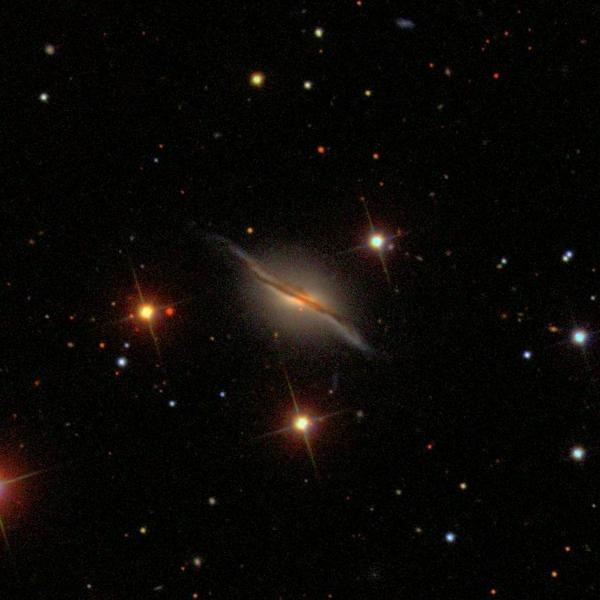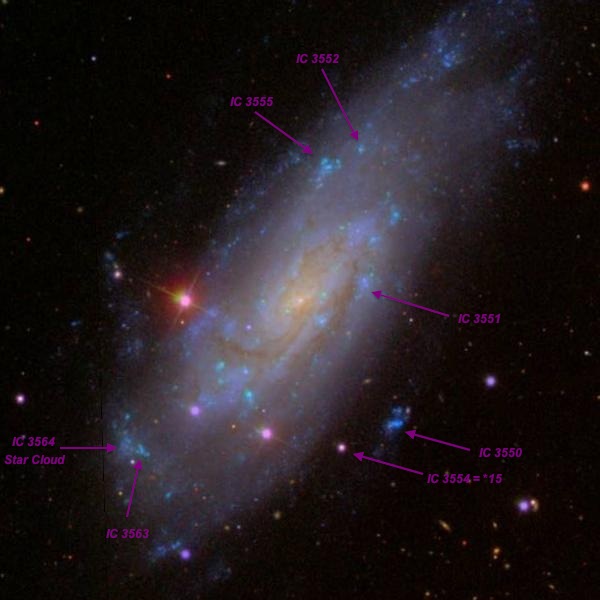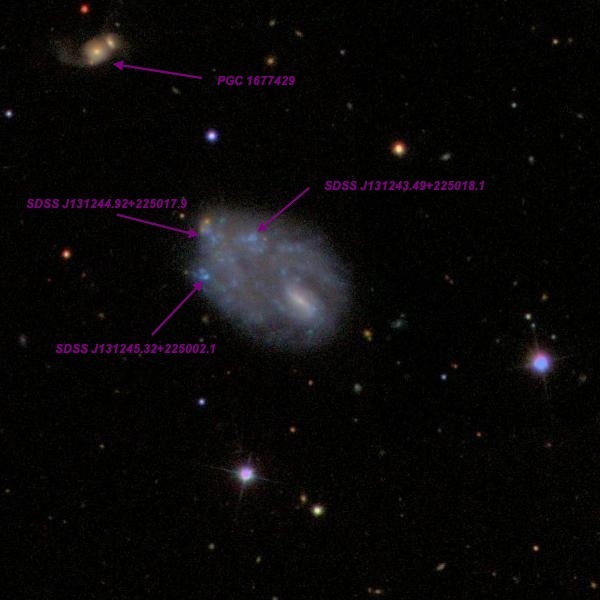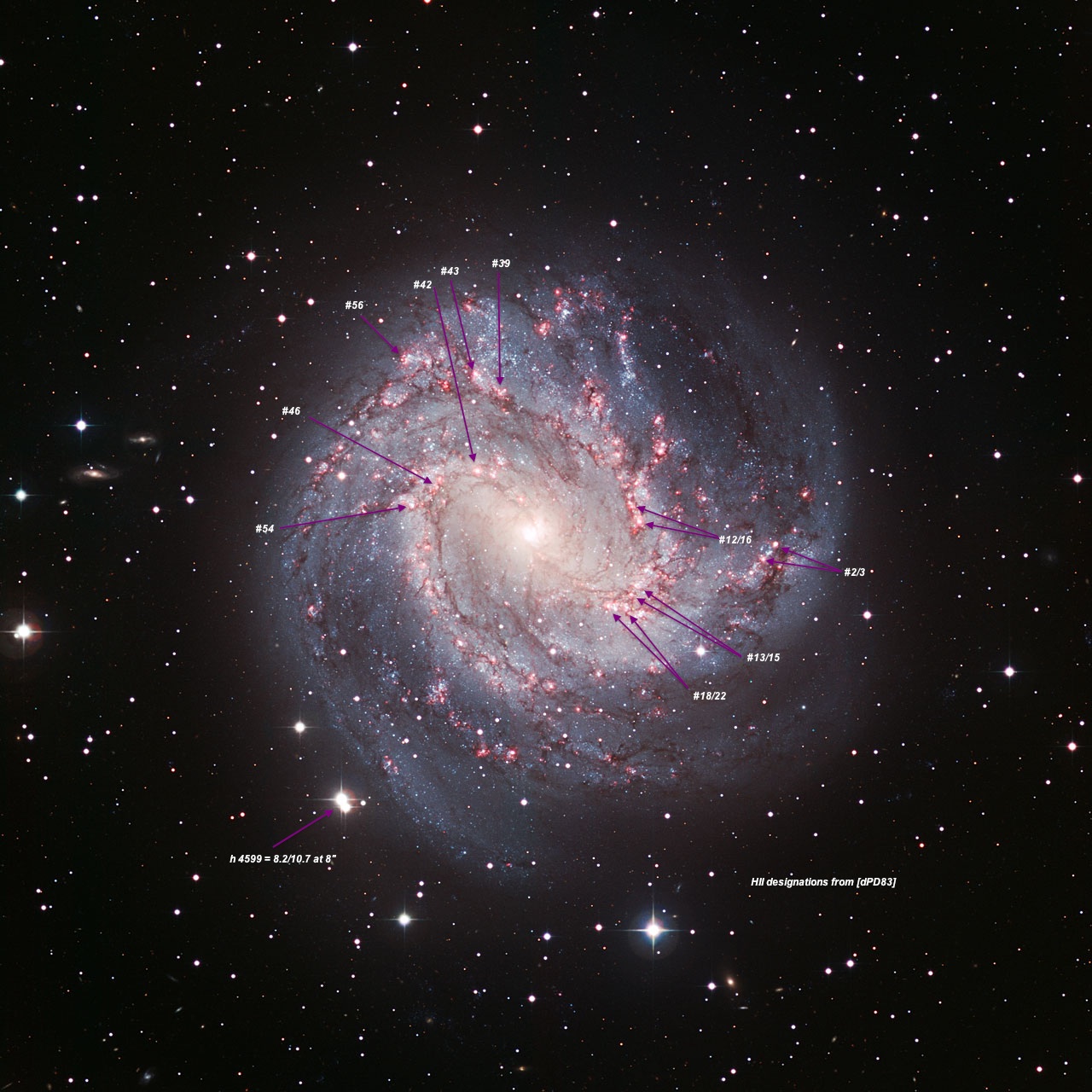|
|
1) UGC 4332: at 375x appeared fairly bright, fairly small, brighter along a thin strip of the major axis, elongated 5:2 WSW-ENE, 20"x8", fairly high surface brightness. A
faint, thin spike extends out of the southwest side, though in soft seeing I couldn't see the corresponding extension on the northeast end. PGC 23359 lies 3.0' S. Centered
within a roughly equilateral triangle of 12th magnitude stars (sides at most 2').
On the SDSS image, this system appears to be a merger, with a warped, dusty, edge-on disc bisecting an elliptical and protruding out the ends. Listed as a "Good Candidate for
Polar-Ring Galaxies" in the 1990 "New Observations and a Photographic Atlas of Polar Ring Galaxies" (AJ, 100, 1489) but in a 2000 study "It is shown that its inclusion in a
list of candidate galaxies with polar rings is erroneous. In reality, it is a spiral galaxy with a powerful bulge and a disturbed dust disk viewed edge-on." |
|
2) HCG 40: This superb HCG (also Arp 321 = VV 116) is arranged in a 1.8' chain oriented N-S (second observation with the 48"): HCG 40A is very bright, moderately large, oval 4:3
N-S, 40"x30", small very bright core, high surface brightness. A mag 15.5 star is 30" NW of center. HCG 40B is bright, fairly small, irregularly round, bright core, high surface
brightness. HCG 40C is moderately bright, very elongated 4:1 NW-SE, 40"x10". HCG 40B is attached at the southeast end and 40E is very close off the east side. HCG 40D is fairly
bright, fairly small, elongated 5:2 WSW-ENE, very small bright nucleus. A mag 14.5 star is off the southeast edge. Finally, 40E is the faintest of 5 in HCG 40 appeared fairly
faint, small, elongated 5:2 SW-NE, 20"x8", very small brighter nucleus. Situated just 45" SE of HCG 40A. |
|
|
|
| 3) NGC 3023: at 375x appeared very bright, large, irregular, asymmetric with a bright, slightly elongated central region, ~40"x30". Extending to the west of
the core is large, faint halo or loop, most evident on the north side of the loop which is brighter and more sharply defined as it sweeps to the west towards companion NGC
3018. The loop extends the diameter to ~1.7'. Mrk 1236, is a very small, but very high surface brightness companion attached on the east side of the core. PGC 1170217 = MAC
0950+0035 was picked up in the field, 4.4' ESE. |
|
| 4) HCG 52: 52A is the brightest member of the HCG 52 quartet with 52B 0.9' NW, 52D 0.8' SW and 52C 2.5' S. It appeared moderately bright, fairly small, elongated 3:2 NW-SE,
25"x18", weak concentration. A mag 17.5 star lies 1.2' SE. Three members have similar redshifts but 52D is half as large. 52B is the second brightest member of the quartet and
appeared faint to fairly faint, edge-on 4:1 WSW-ENE, 24"x6", low even surface brightness. 52C was faint, small, elongated 3:2 E-W, 20"x12", even surface brightness. 52D is the
faintest member of the HCG 52 quartet appeared extremely faint and small, round, 6" diameter. This observation was made during a period of poor transparency. |
|
| 5) NGC 4298/4302: NGC 4298 is very bright, large, oval 2:1 NW-SE, 2.5'x1.5'. Contains a very bright core, which increases to a small bright nucleus. The core is
offset a bit to the NW side. The halo extends further to the southeast side and a weakly defined spiral arm is evident in the outer halo on the west side, extending to the
southeast end. A mag 13.5 star is at the east side, 0.8' from the core. Forms a striking pair with NGC 4302 2' E. This beautiful, thin edge-on stretched at least 8:1 N-S,
~5.0'x0.5'. Contains a brighter, elongated, mottled core. A very thin dust lane extends along the major axis! The core is slightly brighter on the east side of the dust lane.
The northern tip extends beyond a mag 14.2 star off the NW end. A mag 14.3 star is just west of the southern tip. |
|
|
|
>6) NGC 4559: very bright, very large, very elongated 3:1 NW-SE, 9'x3', large bright core that gradually increases to the center. The core is irregular,
mottled and dusty. The inner portion of the disc shows weak spiral structure. At 488x, the outer halo is very patchy with several knots. Superimposed on the southeast side are
three mag 12/12.5/13 stars between 1.5'-2' from center and the galaxy fades out rapidly beyond these stars to the southeast. Near the southeast end is IC 3563, a very compact
HII region and IC 3564, a star association attached on the east side. Both objects were easily visible, but not resolved, as a fairly faint 20" patch, 3' SE of center.
The outer halo fades out gradually and extends much further on the northwest side, extending up to 5' NW of center. IC 3555 is faint, 20"x10" HII region, extended NW-SE, and
situated 1.8' NNW of center in the halo. IC 3552, a smaller HII region close NW, was not seen. IC 3551 is faint, 10" HII knot on the west edge, 0.9' WNW of center. IC 3554 is a
mag 15 star 2.1' SSW of center (at the edge of the visible disc) and IC 3550 = NGC 4559C was seen as a faint, 8" knot, that appears as a small, detached HII knot 0.8' WNW of the
star. All of the IC numbers were found by Max Wolf on a Heidelberg plate in 1903. |
|
| 7) NGC 4618 = Arp 23: fascinating one-armed asymmetric spiral (Arp 23). At 488x the core region is offset to the north side and appeared extremely bright,
irregular, elongated 5:3 SW-NE, 1.6'x1.0'. A prominent, thick, knotty arm is attached on the northeast end and sweeps counterclockwise to the south and then west. IC 3669 is a
brighter arc or section of the arm on the southeast side about 1' SE of the core. IC 3668 is a bright, elongated HII region(s) at the south end of the arm (1.7' S of center),
~20"x10". The arm continues to rotate towards the north on the west side of the galaxy, but this feature has a very low surface brightness and ends roughly west of the core.
Only a faint, diffuse glow was seen to north of the core on the opposite side of the core, with no structure. The total size of the galaxy extended 3.5'x2.5'. Forms a pair with
NGC 4625 8.3' NNE. Interestingly, both galaxies have single prominent arms, though the arm in NGC 4625 was more subtle visually. NGC 4625, a companion to NGC 4618, appeared
bright, fairly large,~1.3' diameter, bright core that is offset to the north side. With careful viewing a low contrast spiral arm is visible along the south side of the halo
with a darker gap between the arm and the south side of the core. |
|
8) NGC 4774: at 488x this collisional ring galaxy appeared fairly bright, fairly small, slightly elongated E-W, irregular. Appeared slightly brighter on the north side,
which contained a faint stellar nucleus, but I didn't resolve the darker center. Forms a close pair with PGC 2087677, about 30" N of center. The companion, which is identified
as the collider in Madore's collisional ring catalogue, appeared very faint (V = 16.7), very small, round, 9" diameter.
NGC 4774 is nicknamed as the "Kidney Bean Galaxy" by Zwicky in his red book (I Zw 45) . It was first mentioned as a ring galaxy in 1970 by Cannon, Lloyd, Penston in "Ring
galaxies" (The Observatory, Vol. 90, p. 153-154) and it is listed as a collisional ring in Madore, Nelson and Petrillo's 2009 "Atlas and Catalog of Collisional Ring Galaxies"
(ApJS, Vol 181, p. 572-604). |
|
9) HZ 46 = Mrk 54: at 488x this very blue starburst galaxy contained a bright, stellar nucleus (perhaps 15th magnitude). Extending to the east was a faint, thin
edge-on, ~18"x6" in size. With careful viewing, a second shorter and fainter "wing", perhaps 10" in length, angled to the northwest and creating an unusual "V" or seagull
shape.
HZ 46 was discovered by Zwicky on a 18-inch Palomar Schmidt plate in 1938 as a faint blue star in the north polar galactic cap region. A couple of years later, Humason analyzed
the spectra and found this object had a high redshift (600 million light years). This was the first Humason-Zwicky "star" that was identified as a galaxy. |
|
| 10) NGC 4861: very unusual appearance at 488x as the galaxy is dominated by a very high surface brightness HII region (Mrk 59) at the SSW end, about 15" in
diameter and 13th magnitude. The knot appeared extremely bright, roundish, sharp-edged. The main glow of the galaxy is very elongated to the NNE, 3.0'x 0.6', extending just past
a mag 13 star near the opposite end. The core is a somewhat brighter, elongated, knotty region, offset closer to the giant HII region. The glow of the galaxy dims as it extends
to the star at the opposite end and fades out just beyond. PGC 101479, a compact galaxy, is exactly in line with the major axis of NGC 4861, 3.5' NNE of the mag 12 star. It
appeared faint or fairly faint (B = 16.8), round, 12"-15" diameter. |
|
| 11) NGC 4900: this unusual galaxy visually appears like a barred ring. At 488x a bright nucleus is embedded with a weak bar, extending NW-SE. A slightly brighter
knot is situated close northwest of the nucleus. A mag 11 star is attached at the southeast end of the galaxy, collinear with the "bar". A large, round halo extends 1.7' and is
slightly brighter along portions of the outer edge, forming a weak ring with a slightly darker interior on either side of the bar. |
|
|
|
| 12) UGC 8290 = "The Apparition": this fascinating galaxy is referred to as both "The Apparition" and "The Sign" by Vorontsov-Vel'yaminov. At 488x, the core
appeared moderately bright, elongated 3:2 SW-NE, 0.3'x0.2', fairly high surface brightness. Extending to the northeast is a large, low surface brightness halo, which appeared
irregular and knotty. This offset halo increased the overall size of the galaxy to ~1.2'x0.8'. On the east end of the halo is a nearly stellar 16-17th mag knot [50" ENE of the
core]. A second low surface brightness knot is at the northeast tip [1.0' NE of the core]. A third very low contrast knot is 40" NE of the core. The SDSS image reveals these are
the brightest of a large number of blue knots. PGC 1677429 lies 2.6' NE. |
|
| 13) M63: extremely bright and large, elongated 2:1 WNW-ESE, 8'x4'. Contains a large, intense, mottled core that increases to a small, brilliant nucleus. At 375x,
the outer halo of this beautiful spiral is resolved into several tightly wrapped spiral arcs that are separated by thin dust lanes. The arm structure is most evident along the
south side of the galaxy with the easiest arm at the outer edge, particularly where it separates at the western end. The galaxy extends just beyond a mag 9.3 star at the
northwest edge. UGCA 342, possibly a detached section of the outer halo of M63, lies 8' WSW of center and 1.2' S of a mag 10.7 star. It appeared extremely faint, fairly small,
elongated 2:1 E-W, 20"x10", very low surface brightness. |
|
|
|
|
14) M83: During this observation of M83, I focused on the HII regions that light up portions of the remarkable spiral arms that emanate from the 3'x1' central bar. The bar
is sharply concentrated with a small, intensely bright, 1' round core. At the northeast end of the bar a high contrast arm begins to sweep counterclockwise along the east
side, ending up directly south of the core. Several knotty clumps were visible in the region where the arm is attached. First, at the northeast end of the central bar [1.2' NE
of center] is NGC 5236:[dPD 83] 42, a 10" HII knot. This designation is from a 1983 paper by de Vaucouleurs, Pence and Davoust that includes a map of the 60 brightest HII
regions. Close east of this knot is #46, a 20"x10" elongated patch, situated where the arm begins to unfurl to the south [1.7' NE of center]. HII region #54 is another 12"
knot a bit further southeast [0.6'] along the arm [1.9' ENE of center].
On the opposite southwest end of the bar a prominent second arm emerges and spirals out counterclockwise along the west side of the galaxy heading north and then spreading out
as it curves east. The arm dims noticeably on the northeast side of the halo near a mag 13 star and has a low surface brightness as it continues south in the outer halo,
heading towards h 4599, an 8" pair of mag 8.2/10.7 stars. Several knots are visible in this arm. As the arm emerges at the southwest end is #22 and #18, a small 10" knot [1.8'
SW of center]. Close north is an elongated clump [2.0' WSW of center], ~25"x10", containing #13 and #15. Another elongated patch, 30"x10", containing #12 and #16, is 1'
further north along the arm [1.9' WNW of center]. Additional HII regions were visible at the northern side of the arm; #39 and #43 are a close pair of small knots ~2.5' NNE of
center. Further east along the arm [3.3' NE of center] is #56, another elongated patch, 20"x10".
A third, wider and more diffuse arm begins on the south side of the bar. It extends below the brighter arm on the west side, and sweeps more gradually, forming an outer
western arm. This arm passes just north of a mag 12 star and ends about 4' W of center at a brighter, elongated patch that includes #2 and #3, as well as a mag 15 star.
|
|
|
15) HCG 66: 66A is the brightest member of this quartet and logged as fairly faint, small, round, 15" diameter, very small bright core. The entire quartet is in a 1' chain!
HCG 66B lies 0.3' E, with 66C 0.5' SE and 66D 0.7' SE. MCG +10-19-103 lies 2.3' NW. This galaxy is simlar to HCG 66A, but was not included as a group member. 66B appeared
faint, very small, elongated 3:2 NNW-SSE, 12"x8". 66C appeared faint, very small, elongated 2:1 N-S, 10"x5". 66D is the smallest and faintest member of this very compact
quartet and at the western end of the chain. At 488x it appeared very faint, extremely small, round, 5" diameter. The 4 members were easily resolved at 488x in soft
seeing.
|
|




